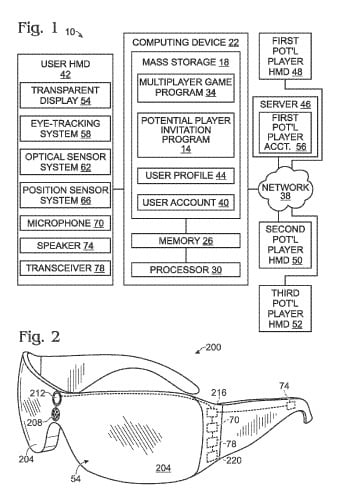Microsoft Moves in to Patent Augmented Reality Glasses for Gaming
There were rumors that Microsoft was developing some kind of gaming glasses last year, and thanks to a patent application, it seems that a Microsoft head-mounted display (HMD) is closer to becoming a reality. The patent is for “multiplayer gaming with head-mounted display”.
However, reading through the patent, it seems that Microsoft is only patenting “a system and related methods for inviting a potential player to participate in a multiplayer game via a user head-mounted display device”. Granted, the means by which one player invites another is impressively complex: “The program receives eye-tracking information, depth information, facial recognition information, potential player head-mounted display device information, and/or potential player voice data. The program associates the invitation with the potential player using the eye-tracking information, the depth information, the facial recognition information, the potential player head-mounted display device information, and/or the potential player voice data.”
Essentially, it seems that Microsoft is teasing a device that portends incredible gaming capabilities but is patenting the most mundane aspect of it. Fortunately, there are more teasers in the text of the patent, including that the HMD could be a pair of glasses with transparent (or semi- or non-transparent, like the Oculus Rift) lenses that offers augmented reality that paints virtual items or objects onto real-world ones.
The HMD would operate via a wired or wireless Internet connection, or Bluetooth. It may also have cloud capabilities, ostensibly to connect to user accounts and profiles.
In terms of hardware, there could be a processor (or more than one) and onboard storage, as well as an eye-tracking system with at least one inward-facing and one outward-facing sensor (which could detect gesture-based inputs or movements performed by another player. The outward-facing sensor alone could boast a depth camera, a visible light camera, an infrared light camera, and a position-tracking camera. Motion sensors can also be input devices and support user movements of the neck and head.
The device could also have one or more microphones, an accelerometer, a gyroscope, a compass, and an orientation sensor.
This HMD sounds like it duplicates some of the features of the Kinect, although it’s reasonable to think that’s because the two would work together, both locally and across an Internet connection with other players.
This is likely a ways off from being a reality, but we can dream can’t we? While we’re doing so, let’s imagine that these specs will somehow work with the IllumiRoom we heard about a few months ago.

However, reading through the patent, it seems that Microsoft is only patenting “a system and related methods for inviting a potential player to participate in a multiplayer game via a user head-mounted display device”. Granted, the means by which one player invites another is impressively complex: “The program receives eye-tracking information, depth information, facial recognition information, potential player head-mounted display device information, and/or potential player voice data. The program associates the invitation with the potential player using the eye-tracking information, the depth information, the facial recognition information, the potential player head-mounted display device information, and/or the potential player voice data.”

Essentially, it seems that Microsoft is teasing a device that portends incredible gaming capabilities but is patenting the most mundane aspect of it. Fortunately, there are more teasers in the text of the patent, including that the HMD could be a pair of glasses with transparent (or semi- or non-transparent, like the Oculus Rift) lenses that offers augmented reality that paints virtual items or objects onto real-world ones.
The HMD would operate via a wired or wireless Internet connection, or Bluetooth. It may also have cloud capabilities, ostensibly to connect to user accounts and profiles.
In terms of hardware, there could be a processor (or more than one) and onboard storage, as well as an eye-tracking system with at least one inward-facing and one outward-facing sensor (which could detect gesture-based inputs or movements performed by another player. The outward-facing sensor alone could boast a depth camera, a visible light camera, an infrared light camera, and a position-tracking camera. Motion sensors can also be input devices and support user movements of the neck and head.
The device could also have one or more microphones, an accelerometer, a gyroscope, a compass, and an orientation sensor.
This HMD sounds like it duplicates some of the features of the Kinect, although it’s reasonable to think that’s because the two would work together, both locally and across an Internet connection with other players.
This is likely a ways off from being a reality, but we can dream can’t we? While we’re doing so, let’s imagine that these specs will somehow work with the IllumiRoom we heard about a few months ago.

